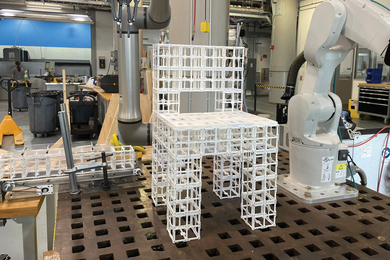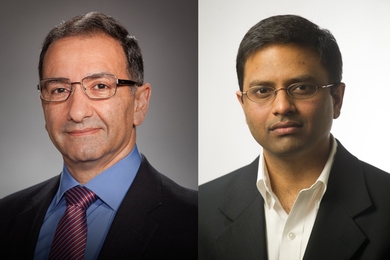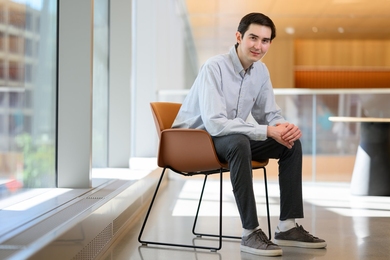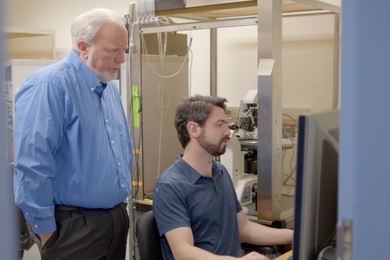Family, friends and even household pets joined the MIT faculty to honor 400-plus doctoral degree recipients as they received their ceremonial hoods in Rockwell Cage last Thursday.
President Charles M. Vest opened the ceremony as well-wishers from all over the world crouched or stretched to get the best sightlines for their cameras and camcorders.
The annual investiture ceremony, at which the newly earned doctoral hood is placed on the shoulders of each honoree, is a light-hearted, child-friendly affair.
Chancellor Lawrence S. Bacow set the tone for the afternoon by advising the new doctors of philosophy or science on the proper position for their tassels. He also drew the whole room's attention to the medieval finery worn by the various faculty members, designating where they received their degrees, making the bleachers where they sat look like one large illuminated manuscript.
Prompted by Chancellor Bacow, Professor Paul A. Lagace (SB 1978, SM, PhD), co-director of the Leaders for Manufacturing Program, modeled the MIT regalia -- gray gown with cardinal red accents -- and Professor Rafael Bras, head of the Department of Civil and Environmental Engineering, wore the gown and frothy lace collar from the University of Perugia in Italy. Princeton University, Stanford University and the University of Chicago were also prominently featured.
Chancellor Bacow, noting that doctoral hoods were originally used as a discreet spot in which students could slip their professors' pay (or alms), remarked, "As an economist I believe this practice truly aligns the interests of the students and the faculty with good teaching." He introduced master of ceremonies Samuel J. Keyser, professor emeritus of linguistics, noting "his beautiful Yale robe" and "his unique qualification as a linguist to read all the names."
In keeping with the family friendliness of the event, Professor Keyser greeted both the about-to-be-hooded and their infants or small children with equal warmth. Often he added in a stage whisper, "Shhh! He's fast asleep!" in reference to a baby lying in the recipient's arms.
Professor Keyser offered fashion commentary only once during the two-hour hooding ceremony. He noted that Thad E. Starner, who received the PhD in media arts and sciences, had created the ''first major modification in the PhD hood since the Middle Ages. Everything he knows is stored in that hood."
Dr. Starner, who concentrated on wearable computing, had built a computer into the fabric of his hood. Wires appeared to connect the hood to his glasses.
While Professor Keyser and representatives from each school invested doctoral degree recipients with their hoods at a stately pace in the front of the room, the back of Rockwell Cage looked like a stroller rally for the Family Leave Act. A parking lot designated for carriages and car seats held more than a dozen empty infant vehicles, while another two dozen children under seven years old kept themselves amused sitting beside their parents and grandparents or chatting with Campus Police by the gym doors.
The School of Engineering awarded the greatest number of hoods -- 171 PhD degrees and 15 doctor of science degrees -- with the School of Science a close second, awarding 131 PhD degrees.
The School of Humanities and Social Science awarded 40 PhDs; the School af Architecture and Planning, 21 PhDs; the Sloan School of Management, 11 PhDs; the Whitaker College of Health Sciences and Technology, 10 PhDs; and the Woods Hole Oceanographic Institute awarded 17 PhD degrees and one doctor of science degree.
A version of this article appeared in the June 9, 1999 issue of MIT Tech Talk (Volume 43, Number 33).





